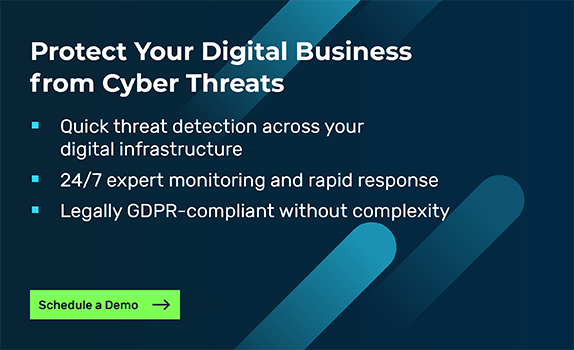Discover how Myra combines digital sovereignty and cyber resilience.
Home>
Web application firewall (WAF)
At a glance
- 01. Web Application Firewall (WAF): A definition
- 02. How Does a Web Application Firewall (WAF) Work?
- 03. What Dangers Does a Web Application Firewall (WAF) Protect Against?
- 04. What Are the Advantages of Using WAF Security?
- 05. What Types of WAFs Are There?
- 06. What can an Application Level Firewall not protect against?
- 07. Which Companies Need a WAF?
- 08. What Do Companies Need to Consider When Using a WAF?
- 09. Web Application Firewall (WAF): What You Need to Know
01
Web Application Firewall (WAF): A Definition
A Web Application Firewall (WAF) sits in front of websites and other application and checks all data going back and forth. It blocks dangerous traffic, like hackers trying to break in, so only safe requests reach the web app. WAFs use rules to spot attacks such as cross-site scripting and SQL injection, helping keep web applications secure. Most WAFs can be set up as software, hardware, or managed cloud services, and their rules are updated to stay ahead of new threats. They make it easier for organizations to meet security standards and protect important data from being stolen.
03
What Dangers Does a Web Application Firewall (WAF) Protect Against?
A web application firewall (WAF) shields web apps from data theft, account takeovers, and malicious acts. Organizations can defend against these attack patterns with a WAF:
Cross-Site Scripting (XSS)
In a cross-site scripting attack, cyber criminals add harmful code to web apps. They exploit security flaws to steal sensitive information, like login details. Interactive websites and applications are particularly susceptible to this. As an upstream protective wall, a web application firewall prevents such malicious access.
SQL-Injection
Cyber criminals use SQL injection attacks to exploit security weaknesses. They insert harmful commands or code through input fields. Dedicated rule sets allow WAF solutions to reliably detect and thwart injection attacks.
OWASP Top 10
OWASP, the non-profit organization, regularly lists the 10 biggest security issues for web applications. Many of the threats on this list can be addressed by a web application firewall.
Zero-Day Exploits
Cyber criminals quickly exploit newly found software vulnerabilities, like Log4Shell or Confluence OGNL. Adapted WAF rules provide immediate protection against these urgent threats. This helps until patches for the vulnerable software are ready and installed.
04 - What Are the Advantages of Using WAF Security?
Companies that use a web application firewall on their website benefit from the following advantages:

Additional Security Layer for Web Applications
An application-level firewall adds extra protection against unauthorized access. It works best with other security measures.

Closing Security Gaps in Multiple Applications
Webmasters can place a WAF in front of several applications at the same time. This procedure makes it possible to close existing security gaps.

Protection of Legacy Systems and Applications
Older software that hasn’t been updated or programmed internally can have lasting security vulnerabilities. A WAF offers additional security here.
05
What Types of WAFs Are There?
You can set up a WAF architecture in three ways:
Centralized, using a network-based hardware or virtual appliance
Host-based, installed directly on the web server
As a cloud SaaS solution from a provider
Depending on the type and deployment, the functionality and associated costs differ immensely.
Network-Based WAF
These web application firewalls can be hardware or virtual appliances. They sit in front of or behind web servers. These solutions provide high scalability and performance. However, they need more bandwidth and a strong infrastructure.
Host-Based WAF
Host-based web application firewalls are software or modules. They run on the same server as the web application. They offer a high level of integration and control options, but also require more resources and high maintenance costs.
Cloud SaaS WAF
Many providers now offer software-as-a-service (SaaS) solutions for web application firewalls (WAF). These cloud-hosted options reduce internal effort for companies. They are also flexible and cost-effective. With a managed WAF, the provider handles configuration, maintenance, and operation of the firewall.
08
What Do Companies Need to Consider When Using a WAF?
A web application firewall is only as good as its filters and configuration. If you make a mistake here or are too restrictive, you can expect problems. Managing a WAF needs skilled IT security specialists. They must have the right resources to handle ongoing firewall management. If companies can't manage this internally, they rely on SaaS solutions from external providers for administrative tasks.
Want to learn more about our solutions, use cases and best practices for attack defense? In our download area you will find product sheets, fact sheets, white papers and case studies.
Deep Dive WAF IT-Security
In-house operation of a WAF (also known as an application level firewall or web app firewall) involves a great deal of effort. Depending on the type, considerable costs are incurred for the necessary hardware, software and operation – in particular, specialist personnel with in-depth knowledge of information security are often difficult to obtain. IT security service providers who offer WAF solutions as a service can help here.
Suitable service providers have the necessary industry experience to ensure efficient operation of the WAF services. The rule sets configured within the WAF must harmonize with the digital business processes of the respective organization. Otherwise there is a risk of downtime and performance losses. A customized configuration by the web application firewall provider is essential for this.
In addition, compliance requirements resulting from laws and regulatory provisions such as the General Data Protection Regulation (GDPR), the NIS 2 Directive or the IT Security Act must be observed when selecting a service provider. As a rule, highly certified providers based in the European Economic Area (EEA) are preferable from a compliance perspective.
About the author
Björn Greif
Senior Editor
About the author
Björn started his career as an editor at the IT news portal ZDNet in 2006. 10 years and exactly 12,693 articles later, he joined the German start-up Cliqz to campaign for more privacy and data protection on the web. It was then only a small step from data protection to IT security: Björn has been writing about the latest trends and developments in the world of cybersecurity at Myra since 2020.





